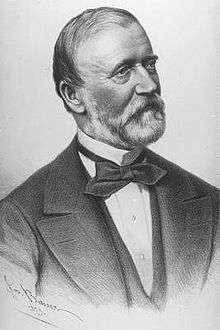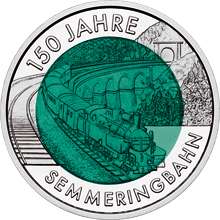Engerth locomotive

The Engerth locomotive was a type of early articulated steam locomotive designed by Wilhelm Freiherr von Engerth [1] for use on the Semmering Railway in Austria.
Designer

Wilhelm von Engerth was born in Pless, Upper Silesia (Now Pszczyna, Poland) on 26 May 1814, the brother of the artist Edouard von Engerth. Initially, he studied architecture, but in 1834 he took up mechanical engineering as a profession. By the late 1850s he was the General Manager of the Imperial Austrian State Railways. Von Engerth was created a Baron (Freiherr) in 1875, and he died on 4 September 1884 in Leesdorf.[2]
History
Von Engerth first patented his design for an articulated locomotive on 11 December 1852.[1][3]
Semmering
The Semmering Railway, opened on 17 July 1854,[4] was one of the first true mountain railways, traversing a section of the Austrian Alps. It was characterized by steep gradients and sharp curves. To work this railway a new design of locomotive was developed.[5]
A competition was held to decide which locomotives would be bought for operation on the Semmering Railway. One stretch of the line had gradients of 1 in 40 (2.5%) and curves with a minimum radius of 190 metres (210 yd) and a maximum radius of 285 metres (312 yd). A speed of 11.5 kilometres per hour (7.1 mph) was required to be maintained and a maximum axle loading of 14 tonnes, with a boiler pressure not exceeding 8.5 kgf/cm² (830 kPa). There were four entrants, Bavaria, built by Maffei; Wiener-Neustadt built by Wiener-Neustadt; Seraing built by Société anonyme John Cockerill in Belgium and Vindobona built by the Glognitz Bahn in Vienna. All four locomotives fulfilled the conditions of the trial, but did not prove reliable in practice. The Semmering Trials lead to a number of developments in locomotive design:- Fairlie's Patent of 1863, The Meyer locomotive and the Mallet locomotive.[6]
The Engerth design articulated the tender with the main locomotive frame, allowing some of the weight of the fuel and water to be carried on the driving wheels to improve adhesion. Because the tender was articulated, rather than directly attached to the frame, the locomotive could traverse relatively sharp curves, while still enjoying the advantage of the additional adhesive weight gain. The original design also included an indirect drive from the main driving wheels to the wheels under the tender. This arrangement proved too complex to maintain and was dropped from the design.[5]
Sixteen locomotives were supplied to the Semmering Railway between November 1853 and May 1854. They proved capable of 19 kilometres per hour (12 mph) uphill on gradients of 1 in 40 (2.5%). An Engerth locomotive was featured on an Austrian stamp commemorating the 150th anniversary of the Semmering Railway in 2004.[4] The Engerth locomotive also appeared on a 25 Euro coin issued by Austria in 2004.
Other Engerth locomotives

The design proved popular, especially for use in Alpine mountain railways. Engerth locomotives were found with wheel arrangements of 0-4-4T, 0-4-6T, 2-6-2T, 0-6-4T, 0-8-4T and 0-8-6T. As well as in Austria, they were used in Bosnia and Herzegovina, France, Italy, Java, Romania, Spain and Switzerland. Krauss of Munich built ten locomotive for the Ponferrada - Villablino railway (PV) in Spain. Some narrow gauge 2-6-0T locomotives were built for the Ferrocaril de Elgoibar a San Sebastián. These powerful locomotives were capable of 60 kilometres per hour (37 mph) and could traverse curves of 100 metres (110 yd) radius. Two of these locomotives were later sold to the PV. Another four locomotives built by MACOSA in Spain were also bought by the PV. Three of the PV locomotives were in service until 1989.[3] Thirteen Engerth locomotives were supplied to the Oraviţa - Bazias railway in Romania in 1854.[7]
Fink variation
A variation of the Engerth system was devised by Pius Fink. This entailed having the rear wheels also driven by coupling rods from a crankshaft, thus making the locomotive an 0-6-4-0T. One locomotive was built by the Staats Eisenbahn Gesellschaft, Vienna in 1861 carried No. 500 and was named Steyerdorf. It was used on the Reschtiza - Orawicza line. Three more were built, the last in 1867. These included No. 501 Krassova and No. 502 Gerliste. One of these four locomotives survived until 1891, becoming Hungarian State Railways No.4270.[8][9]
Preservation

One example of the Engerth type is preserved at the Swiss Transport Museum in Lucerne. This locomotive, No.28 Genf an 0-4-6T built by Maschinenfabrik Esslingen in 1858 to work the Schweizerische Centraalbahn (Swiss Central Railway). She retired from active service in 1899 and was used as a static boiler at Olten. She is the oldest locomotive in Switzerland.[10][11]
Buštěhradská dráha (Buštěhrad Railway) locomotive 103 Kladno[12] is preserved in the National Technical Museum in Prague, Czech Republic.[13]
All six of the narrow gauge NÖLB Mh or 399 class Engerth locomotives survive in Austria.[14] These 760mm gauge 0-8+4 (D2h2t) locomotives were built by Krauss for the Mariazellerbahn in 1906 and 1908. When the Mariazellerbahn was electrified the Niederosterreichische Landesbahn (NOLB) transferred them to their Waldviertler Schmalspurbahnen system at Gmund. When the ÖBB took over in 1922 the locomotives were redesignated the 399 class.
Mh1 / 399.01 (5431/1906) is part of the ÖBB heritage fleet. It is currently based at Gmund, ÖBB-Erlebnisbahn.
Mh2 / 399.02 (5432/1906) is part of the ÖBB heritage fleet. It is currently based at Gmund, ÖBB-Erlebnisbahn.
Mh3 / 399.03 (5433/1906) was sold to the Pinzgauer Lokalbahn. It is currently based at Zell-am-Zee.
Mh4 / 399.04 (5434/1906) is part of the ÖBB heritage fleet. It is currently based at Gmund, ÖBB-Erlebnisbahn.
Mh5 / 399.05 (5924/1908) is privately owned. It is currently based at Heidenreichstein on the Waldviertler Schmalspurbahnverein (WSV) [15]
Mh6 / 399.06 (5925/1908) is preserved on the Mariazellerbahn in Austria.[16][17]
Chemins de fer du Midi 0-6-4T locomotive no.312 L'Adour is preserved at the Musée Français du Chemin de Fer, Mulhouse, France.[18]
Reproduction
The Beer Heights Light Railway has Gem, an Engerth type locomotive on its 7 1⁄4 in (184 mm) gauge line.[19]
Further reading
- Carling, D.R. (1985–1986). "Engerth and similar locomotives". Transactions of the Newcomen Society. 57.
References
- 1 2 "Continental engineers". Retrieved 23 March 2008.
- ↑ Translated from the German article
- 1 2 "LOCOMOTORAS DE VAPOR DEL PV" (in Spanish). Wefer. Retrieved 25 March 2008.
- 1 2 "Series 'Locomotives' - Imperial and Royal Southern State Railway - the Engerth Locomotive". Stamp News. Retrieved 25 March 2008.
- 1 2 Hamilton Ellis, Cuthbert (1973). The Pictorial Encyclopedia of Railways. Hamlyn. ISBN 0-600-03075-X.
- ↑ "The Semmering contest, 1851". René Vink. Retrieved 25 March 2008.
- ↑ "The history of Romanian Railways". CFR. Retrieved 25 March 2008.
- ↑ "AUSTRIA-HUNGARY 1861". Robin Barnes. Retrieved 25 March 2008.
- ↑ "Shaft CounterShaft: The Fink System". Douglas Self. Retrieved 26 March 2008.
- ↑ "The Journey Out & 'Verkehrshaus' The Swiss State Transport Museum, Lucerne". Martyn Bane. Retrieved 26 March 2008.
- ↑ "The Railways of Switzerland, How it all started". Wymann. Retrieved 26 March 2008.
- ↑ cs:Lokomotiva Kladno
- ↑ "Steam locomotive KLADNO". National Technical Museum in Prague. Retrieved 25 March 2008.
- ↑ "Austrian Steam Base". dampflok.at. Retrieved 5 April 2015.
- ↑ http://www.waldviertelbahn.info/wsv/spendenaktion.pdf
- ↑ "The Mariazellerbahn". Friends of the Mariazellerbahn. Retrieved 25 March 2008.
- ↑ "Dampflok Mh.6". Friends of the Mariazellerbahn. Retrieved 25 March 2008.(German)
- ↑ "La 032 Engerth 312 "L'Adour"". Bruno Pérès. Retrieved 25 March 2008.
- ↑ "Beer Heights Light Railway". Peco. Archived from the original on 5 March 2008. Retrieved 25 March 2008.
External links
- Photo and description of Engerth locomotive (Italian).
- Photo of an Engerth locomotive.
- Review of CD with Javan Engerth locomotives mentioned.
